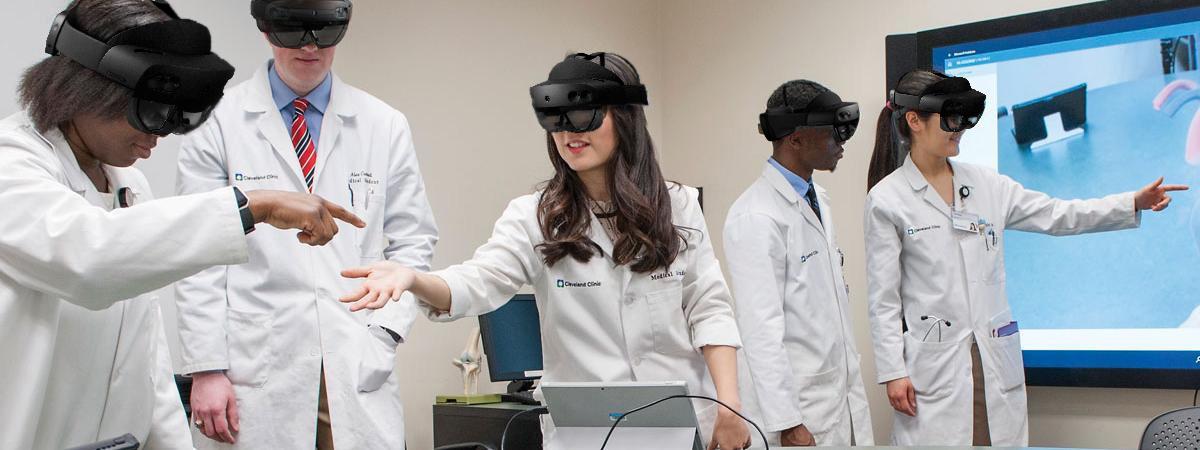HoloAnatomy® Software Suite was extensively tested throughout its development. More than a dozen pilot studies and classroom review sessions took place between 2016-2019. These pilots tested both the medical illustration and the technology: 3D Anatomy Art, Designer Tool, Networking Infrastructure, and overall HoloLens learning outcomes.
Study shows significantly more positive
responses to mixed-reality and finds mixed-reality easier for learning and teamwork.
2022 May
Abstract Objectives: To evaluate student impressions of learning anatomy with mixed-reality and compare long-term information retention of female breast anatomy between students who learned with a mixed-reality supplement and their classmates who dissected cadavers.
Methods: In Part 1, 38 first-year medical student volunteers, randomly divided into two groups, completed a mixed-reality module and cadaveric dissection on the female breast in a counterbalanced design. Participants also completed post quizzes and surveys. Part 2 was a non-randomized controlled trial, 8-months after completing Part 1 and 6-months after a final exam on this content. The performance of twenty-two
Part 1 participants and 129 of their classmates, who only dissected, was compared on a delayed post-quiz. Wilcoxon signed-rank test, Mann-Whitney U test, and 95% confidence
intervals were used to analyze the data. Results: In Part 1, the Wilcoxon signed-rank test determined
that participants expressed significantly more positive responses to mixed-reality and found mixed-reality easier for
learning and teamwork. In Part 2, the Mann-Whitney U test found mixed-reality participants scored significantly higher on a delayed-post quiz than their classmates who only dissected (U = 928, p < .009).
Conclusions: This study suggests that medical students may prefer mixed-reality and that it may be an effective modality for learning breast anatomy while facilitating teamwork. Results also suggest that supplementing cadaveric dissection with mixed-reality may improve long-term retention for at least one anatomical topic. It is recommended that similar studies evaluate a larger sample and additional anatomical regions to determine the generalizability of these findings.
Follow the link in the title for complete findings.
Assessment of Mixed-Reality Technology Use in Remote Online Anatomy Education
2020 September
Susanne Wish-Baratz, PhD, MBA; Andrew R. Crofton, PhD; Jorge Gutierrez, BA; Erin Henninger, MBA; Mark A. Griswold, PhD. JAMA Netw Open. 2020 Sep; 3(9): e2016271. Published online 2020 Sep 17. DOI: 10.1001/jamanetworkopen.2020.16271
The coronavirus disease 2019 (COVID-19) pandemic has presented challenges for education worldwide, especially in medical schools that rely on cadaver-based dissection for anatomy. The advent of commercial mixed-reality (MR) technology, such as the HoloLens (Microsoft Corporation), offers new possibilities for anatomy education.1 At CaseWestern Reserve University (CWRU), the state of Ohio’s shelter in place order meant that students did not return from spring break in 2020, requiring an urgent modification to the anatomy curriculum, which has featured MR technology since 2018.2. We report our initial experience using MR to teach anatomy remotely to students located throughout North America.
Mixed Reality as a time-efficient alternative to cadaveric dissection
2020 August
Ruthberg, J., Tingle, G., Tan, L., Ulrey, L., Simonson-Shick, S., Enterline, R., ... & Wish-Baratz, S. (2020). Medical Teacher Volume 42, 2020 - Issue 8 DOI:10.1080/0142159X.2020.1762032, Pages 896-901
The extent of medical knowledge increases yearly, but the time available for students to learn is limited, leading to administrative pressures to revise and reconfigure medical school curricula. The goal of the study was to determine whether the mixed reality platform HoloAnatomy® Software represents an effective and time-efficient modality to learn anatomy when compared to traditional cadaveric dissection.
Mixed Reality Anatomy Using Microsoft HoloLens and Cadaveric Dissection: A Comparative Effectiveness Study
2019 November
Stojanovska, M., Tingle, G., Tan, L., Ulrey, L., Simonson-Shick, S., Mlakar, J., ... & Wish-Baratz, S. (2019). Medical Science Educator volume 30, pages173–178(2020)
As the amount of curricular material required of medical students increases, less time is available for anatomy; thus, methods to teach anatomy more efficiently and effectively are necessary. In this randomized controlled trial, researchers looked at the effectiveness of a mixed reality device to teach musculoskeletal anomy to medical students compared with traditional cadaveric dissection.
A new supplement to gross anatomy dissection: HoloAnatomy®
2019 May
Wish-Baratz, S., Gubatina, A. P., Enterline, R., & Griswold, M. A. (2019). Medical Education, 53(5), 522-523 Volume53, Issue5, Pages 522-523
Cadaver vs. Microsoft HoloLens: A Comparison of Educational Outcomes of a Breast Anatomy Module
2018 April
Yong, V., Sridharan, P., Ali, S. A., Tingle, G., Enterline, R., Ulrey, L., ... & Wish-Baratz, S. (2018). The FASEB Journal, 32(1_supplement), 635-6.
Volume32, IssueS1 Experimental Biology 2018 Meeting Abstracts Pages 635.6-635.6
Microsoft Hololens mixed reality technology offers students a novel modality to visualize clinically important anatomical structures, such as the breast, which are uniquely challenging to discern with the naked eye in traditional cadaveric dissection. In this study, a 3D anatomical model of the breast was developed and integrated it into a dynamic, educational module on the HoloLens. The educational outcomes and overall impressions of medical students learning breast anatomy through our module, as compared with traditional dissection are reported in the study.


